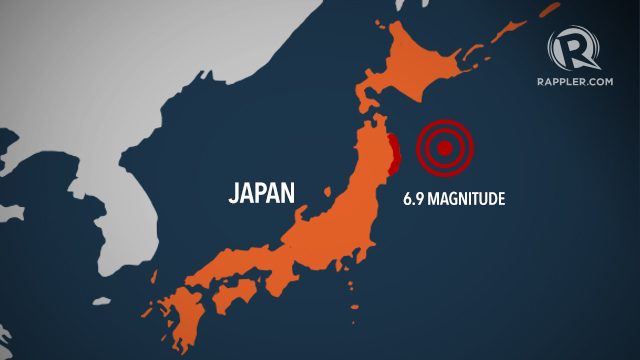SUMMARY
This is AI generated summarization, which may have errors. For context, always refer to the full article.

TOKYO, Japan (4th UPDATE) – A minor tsunami hit northern Japan Tuesday, February 17, after a strong undersea earthquake struck off the coast, in the same area that was devastated by a killer tsunami in 2011.
A wave of 20 centimeters (eight inches) was recorded in Kuji, eastern Iwate, at 9:07 am local time (0007 GMT), way below the possible one meter (3.3 feet) tsunami that the Japan Meteorological Agency (JMA) warned could hit.
The agency warned waters were still rising slightly in Kuji, although they were unlikely to swell too much further.
Waves of up to 10 centimeters were recorded along other parts of the coastline of Iwate prefecture.
There were no immediate reports of damage or casualties.
Aerial footage showed no perceptible rise in sea level along the coast. There was no visible change at the ports in the area, where broadcaster NHK has cameras permanently stationed.
The JMA said the 6.9 magnitude tremor struck at 8:06 am local time in the Pacific some 210 km (130 miles) east of Miyako, at a depth of 10 km.
An official told a Tokyo news conference that geologists regard the quake as an aftershock of the 2011 earthquake.
The US Geological Survey put the magnitude at 6.7.
As soon as the quake hit, Japan’s well-tested system of public alerts sprang into action, with NHK giving blanket coverage.
Announcers urged viewers to seek safety on higher ground and warned against going to the shore to watch possible effects.
Public address systems all along the coast also broadcast warnings, while emergency vehicles patrolled with their sirens blaring, as announcements told people to find refuge.
“So far we have seen a minor tsunami but we continue to warn our citizens not to approach the coast as second and third waves could be higher,” said Masayuki Yamazaki, an official in the anti-disaster office in Miyako.
Another Miyako official said: “The quake was strong and shook buildings but we have not heard of any damage.”
Local authorities in Iwate issued evacuation advisories to more than 19,000 people, NHK reported.
Large areas of the coastline covered by the advisory were ruined by the 2011 quake and tsunami, which left more than 18,000 people dead and triggered a nuclear accident in Fukushima.
The 9.0 undersea quake set off a massive tsunami that swamped cooling systems at the Fukushima Daiichi power plant, sparking the worst atomic accident in a generation.
Hundreds of thousands of people were evacuated around the plant amid fears of rising radiation, with many still unable to return to their homes.
The disaster, whose fourth anniversary falls on March 11, looms large in the Japanese psyche; the devastation and loss of life that it wrought reinforcing the country’s natural cautiousness in the face of danger.
Japan is hit by around 1/5 of the world’s most powerful quakes every year due to its position at the conjunction of several tectonic plates.
Long experience has left it with strict building codes, such that powerful earthquakes that might raze cities in other countries tend to do little damage. – Rappler.com
Add a comment
How does this make you feel?
There are no comments yet. Add your comment to start the conversation.